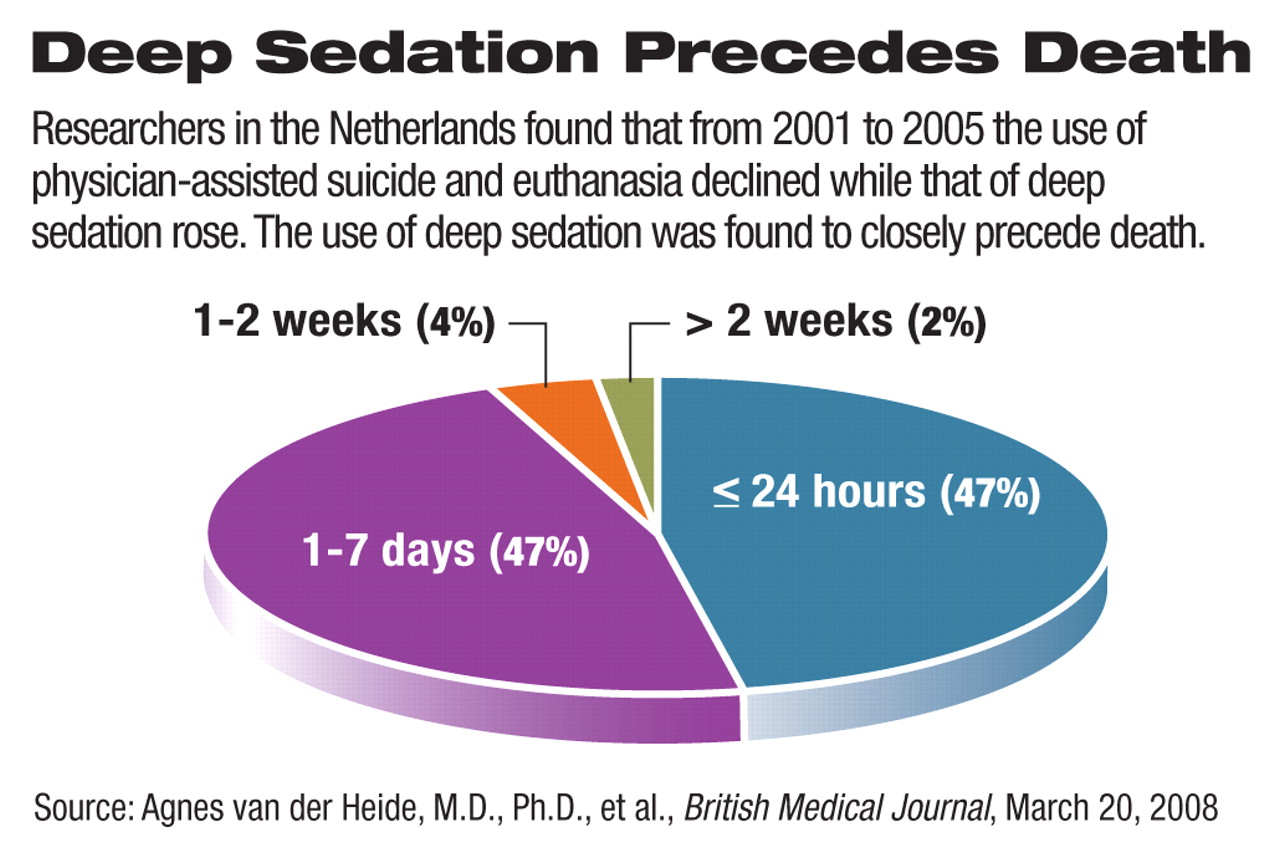Although euthanasia and physician-assisted suicide became legal in the Netherlands only in 2002, they had been practiced there for at least a decade before. Thus, it was logical to expect that after they became legal, their practice would remain stable or perhaps even increase.
Surprisingly, however, their practice declined. In 2001 in the Netherlands, 2.6 percent of deaths resulted from euthanasia and 0.2 percent resulted from physician-assisted suicide. In 2005 in the Netherlands, 1.7 percent of deaths resulted from euthanasia and 0.1 percent of deaths resulted from physician-assisted suicide.
So reported Agnes van der Heide, M.D., Ph.D., an associate professor of public health at Erasmus Medical Center in Rotterdam, and colleagues in the May 10, 2007, New England Journal of Medicine.
The reason for this unexpected decline, van der Heide and her team have now found, seems to be because continuous deep sedation until death has replaced euthanasia and physician-assisted suicide as the preferred option for dealing with terminally ill patients' pain and anxiety. They published these results in the online British Medical Journal on March 14.
In the Netherlands, continuous deep sedation to death consists of a physician giving a terminally ill patient continuous deep sedation until he or she dies. The intent is to relieve pain and anxiety—not to hasten death, which is the case with physician-assisted suicide and euthanasia. (Under the law in the Netherlands, euthanasia constitutes a physician giving a patient, at his or her request, a medication to hasten death.)
Specifically, van der Heide and her team found that precisely during the years in which the practice of euthanasia and physician-assisted suicide in the Netherlands declined—between 2001 and 2005—the practice of continuous deep sedation until death in terminally ill patients increased from 5.6 percent in 2001 to 8.2 percent in 2005. Moreover, the use of continuous deep sedation until death increased in precisely those subgroups in whom euthanasia and physician-assisted suicide had been most commonly used—in terminally ill patients attended by general practitioners and in terminally ill patients with cancer.
Possible Explanations Offered
Yet if continuous deep sedation until death indeed preempted euthanasia and physician-assisted suicide as the method of choice for dealing with certain terminally ill patients' pain and anxiety, why was this so? One possible explanation, van der Heide and her coworkers suggested in their British Medical Journal report, is that from 2002 on, regional cancer centers in the Netherlands have published guidelines on how to use continuous deep sedation until death. Another possible explanation, they wrote, is that“ the practice of continuous deep sedation until death also received a lot of attention in the media.” And yet a third possible explanation, they proposed, is that since continuous deep sedation until death does not require special judicial supervision as euthanasia and physician-assisted suicide do, it is easier for physicians to administer.
So at this juncture, van der Heide and her team concluded, continuous deep sedation until death might be viewed as “normal medical practice” in the Netherlands.
Ethical Questions Raised
Nonetheless, continuous deep sedation until death does raise ethical questions, they wrote.
For example, there is the question of who should have the right to decide on continuous deep sedation until death. As things currently stand, van der Heide told Psychiatric News, “it is the physician who makes the decision, often after discussing it with the patient, or if that is impossible, with the patient's family.”
Furthermore, there is this question: even if continuous deep sedation until death is given to relieve pain and anxiety, should it still be used if it hastens death as a side effect? van der Heide and her colleagues asked Dutch physicians who used continuous deep sedation until death in 2005 whether the technique had ever shortened their patients' lives. The physicians replied that it probably had in certain instances.
Another consideration, van der Heide and her group pointed out, is that“ [r]endering patients unconscious until death is a far-reaching intervention that has an important impact on the dying process for both the patient and the relatives. Whether and how such sedation contributes to a dignified death deserves further study.”
As for continuous deep sedation until death in the United States, it is“ legally permissible,” Timothy Quill, M.D., a professor of psychiatry and director of the Center for Ethics, Humanities, and Palliative Care at the University of Rochester, wrote in an editorial accompanying the researchers' report in the New England Journal of Medicine. Nonetheless, it is “ethically controversial,” he admitted.“ It is used as a last-resort option in some very challenging cases, accounting for anywhere from 0 to 50 percent of deaths in hospice programs, depending on definitions, values, and providers' practice patterns.”
E. James Lieberman, M.D., a clinical professor of psychiatry at George Washington University who has special interest in end-of-life topics, does not believe that the use of, and controversy over, continuous deep sedation has major implications for American psychiatry. Of greater concern to American psychiatrists, he said, “is whether physician-assisted suicide, as allowed in Oregon, can be defended as rational behavior on the part of patients and as ethical behavior on the part of doctors.”
The study was funded by the Dutch Ministry of Health.
An abstract of “Continuous Deep Sedation for Patients Nearing Death in the Netherlands: Descriptive Study” is posted at<www.bmj.com/cgi/content/abstract/bmj.39504.531505.25v2>.▪

